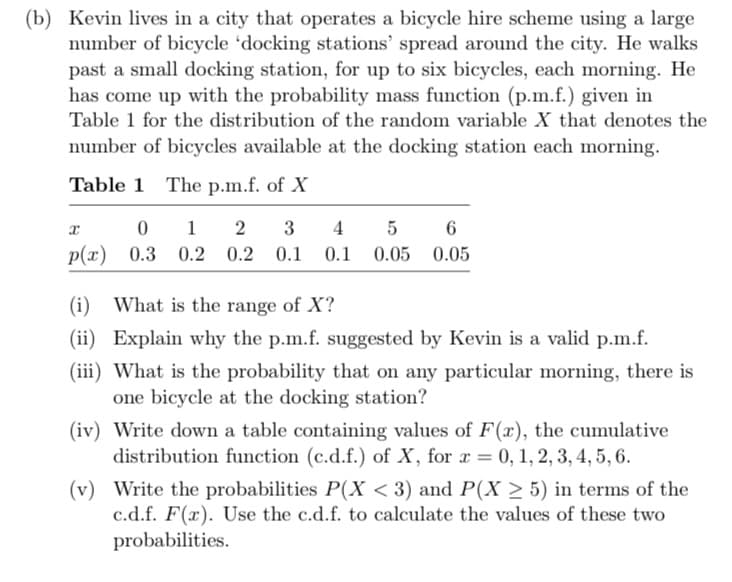(b) Kevin lives in a city that operates a bicycle hire scheme using a large number of bicycle 'docking stations' spread around the city. He walks past a small docking station, for up to six bicycles, each morning. He has come up with the probability mass function (p.m.f.) given in Table 1 for the distribution of the random variable X that denotes the number of bicycles available at the docking station each morning. Table 1 The p.m.f. of X x 0 1 2 3 4 5 6 p(x) 0.3 0.2 0.2 0.1 0.1 0.05 0.05 (i) What is the range of X? (ii) Explain why the p.m.f. suggested by Kevin is a valid p.m.f. (iii) What is the probability that on any particular morning, there is one bicycle at the docking station?
(b) Kevin lives in a city that operates a bicycle hire scheme using a large number of bicycle 'docking stations' spread around the city. He walks past a small docking station, for up to six bicycles, each morning. He has come up with the probability mass function (p.m.f.) given in Table 1 for the distribution of the random variable X that denotes the number of bicycles available at the docking station each morning. Table 1 The p.m.f. of X x 0 1 2 3 4 5 6 p(x) 0.3 0.2 0.2 0.1 0.1 0.05 0.05 (i) What is the range of X? (ii) Explain why the p.m.f. suggested by Kevin is a valid p.m.f. (iii) What is the probability that on any particular morning, there is one bicycle at the docking station?
Chapter8: Sequences, Series,and Probability
Section8.7: Probability
Problem 11ECP: A manufacturer has determined that a machine averages one faulty unit for every 500 it produces....
Related questions
Question

Transcribed Image Text:(b) Kevin lives in a city that operates a bicycle hire scheme using a large
number of bicycle 'docking stations' spread around the city. He walks
past a small docking station, for up to six bicycles, each morning. He
has come up with the probability mass function (p.m.f.) given in
Table 1 for the distribution of the random variable X that denotes the
number of bicycles available at the docking station each morning.
Table 1 The p.m.f. of X
x
6
012 3 4 5
p(x) 0.3 0.2 0.2 0.1 0.1 0.05 0.05
(i) What is the range of X?
(ii) Explain why the p.m.f. suggested by Kevin is a valid p.m.f.
(iii) What is the probability that on any particular morning, there is
one bicycle at the docking station?
(iv) Write down a table containing values of F(x), the cumulative
distribution function (c.d.f.) of X, for x = 0, 1, 2, 3, 4, 5, 6.
(v) Write the probabilities P(X < 3) and P(X ≥ 5) in terms of the
c.d.f. F(x). Use the c.d.f. to calculate the values of these two
probabilities.
Expert Solution
This question has been solved!
Explore an expertly crafted, step-by-step solution for a thorough understanding of key concepts.
Step by step
Solved in 4 steps

Recommended textbooks for you

